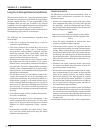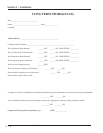
3 – 5
VSG/VSSG • Installation, Operation and Maintenance Manual •Vilter/Emerson • 35391SSG
Section 3 • Installation
Foundation
Vilter Single Screw compressor units are low vibra-
tion machines. Under most conditions, no elaborate
foundation is necessary. However a sound foundation
maintains motor alignment and proper elevation, and
is therefore required. Provided are recommendations
for the foundation and anchoring of the compressor
unit. The Vilter foundation supports the entire operating
weight of the unit and is suitable for years of continuous
duty. Included are specifi cations for concrete, rebar, ag-
gregate, anchors and grout.
Considerations Prior to Starting
Consult professionals, such as building inspectors,
structural engineers, geotechnical engineers and/or
construction contractors prior to starting. Below are a
few points to consider:
Site Characteristics:
• Soil information
• Site drainage
• Wind data
• Seismic zone
• Ingress and egress
• Power and power lines
Site Layout:
• Plant elevations, grading, drainage and erosion
• Accessibility to compressors for service
• Location of surrounding buildings
• Property lines and roadways
• Power
• Fire safety
Safety:
NOTE
Always check with a safety engineer before proceeding.
• Arranging equipment with adequate access space for
safe operation and maintenance
• Wherever possible, arrange equipment to be served
by crane. If not feasible, consider other handling
methods
• Make all valves and devices safely accessible
• Use special bright primary color schemes to differen-
tiate service lines
• Lightening protection for outdoor installations
• Relief valve venting
Foundation Materials
Materials needed to build the foundation are forms,
concrete, sand, rebar, wire, grout, anchor bolts, ex-
pansion board and shims. A set of concrete forms will
need to be acquired; generally, these can be rented or
constructed from dimensional lumber. There should
be enough 4,000 psi concrete with one inch aggregate
to build the foundation. Also, there should be enough
sand to provide a base of compacted sand four inches
thick for the foundation to rest on, see Figure 1 - Con-
crete Pad with Compressor Unit Dimensions - Side
View. The rebar required is ASTM 615, grade 60, sizes
#4 and #6. Wires will also be needed to tie the rebar
together. The recommended grout is Masterfl ow 648CP
high performance non-shirk grout to provide at least
a 1” thick pad under each foot. The recommended an-
chors are 5/8” Diameter HILTI HAS SS threaded rod for
outdoor installations or HAS-E rods for indoor installa-
tions. Anchor bolts shall have a fi ve inch projection and
12-3/8” embedment. The required adhesive is HIT-ICE/
HIT/HY 150 anchoring system. There should be enough
one inch expansion boards to go around the perimeter
of the foundation. Finally there should be enough shim
stock and extra anchor bolt nuts to level the compres-
sor unit.
Building the Foundation
Use the Vilter General Arrangement (GA) and founda-
tion drawings to help secure a building permit and
foundation construction. The Vilter GA drawing will
have the necessary dimensions required to determine
the overall foundation size and where to locate the
compressor unit on the foundation. It will also show the
dimensions required to form up the housekeeping piers
that the compressor unit rests on. The Vilter foundation
drawing lists the necessary information to construct a
suitable foundation. It includes the rebar requirements
and locations. It also shows anchor bolt locations,
grouting and the concrete specifi cations. Using the
Vilter GA drawing, Vilter foundation drawing and the
information from site characteristics, site layout and
safety studies will provide enough data to allow build-
ing the foundation to proceed.
The foundation is to be cast and permanently exposed
against the earth. Therefore, if constructing on an exist-
ing fl oor, typically indoors, the fl oor will need to be bro-
ken up to get to the earth. If starting from undisturbed
soil, it must be also be prepared accordingly. In either
case, these are some check points to consider:
• Check the depth of your frost line to ensure
the foundation extends below it
• Ensure the foundation rests entirely on natural rock
or entirely on solid earth, but never on a combination


















